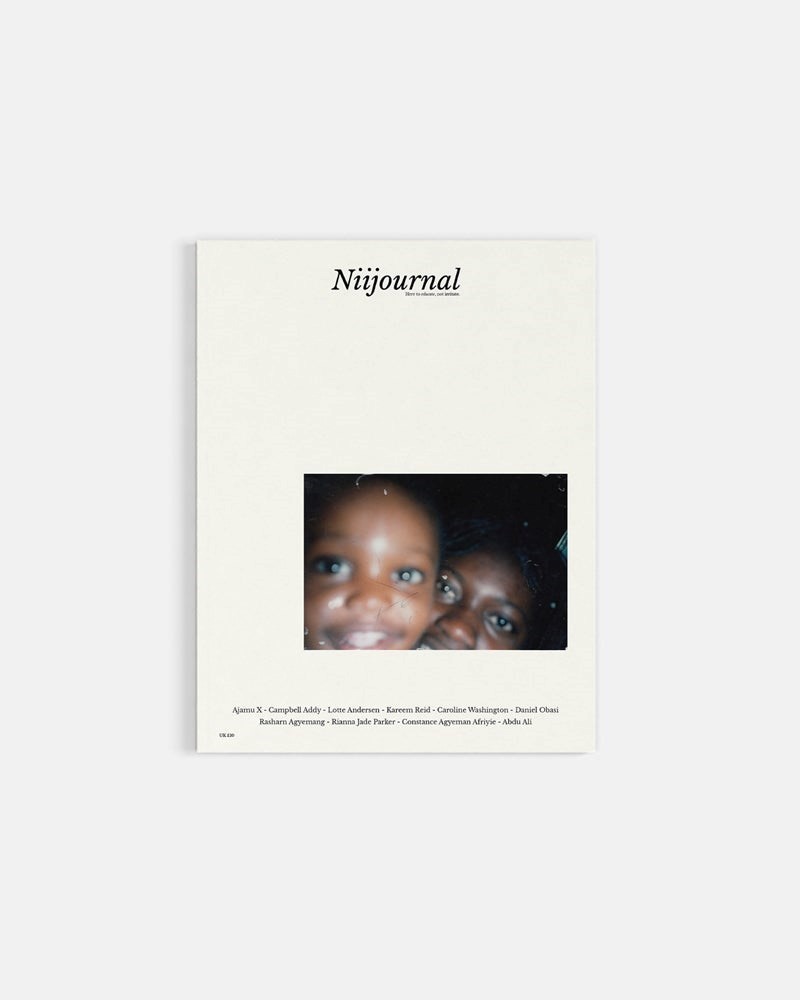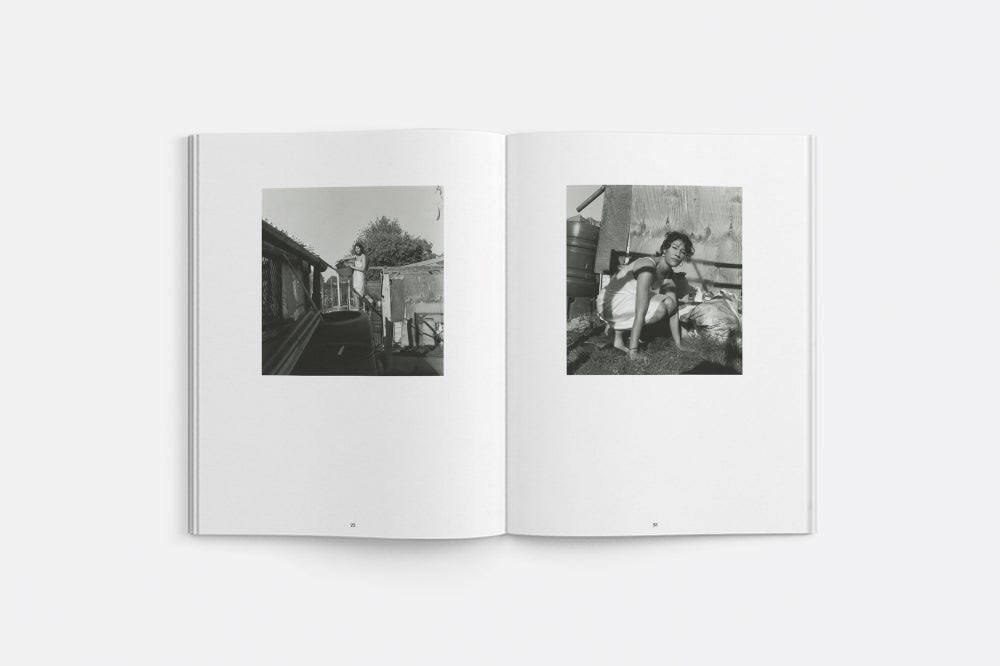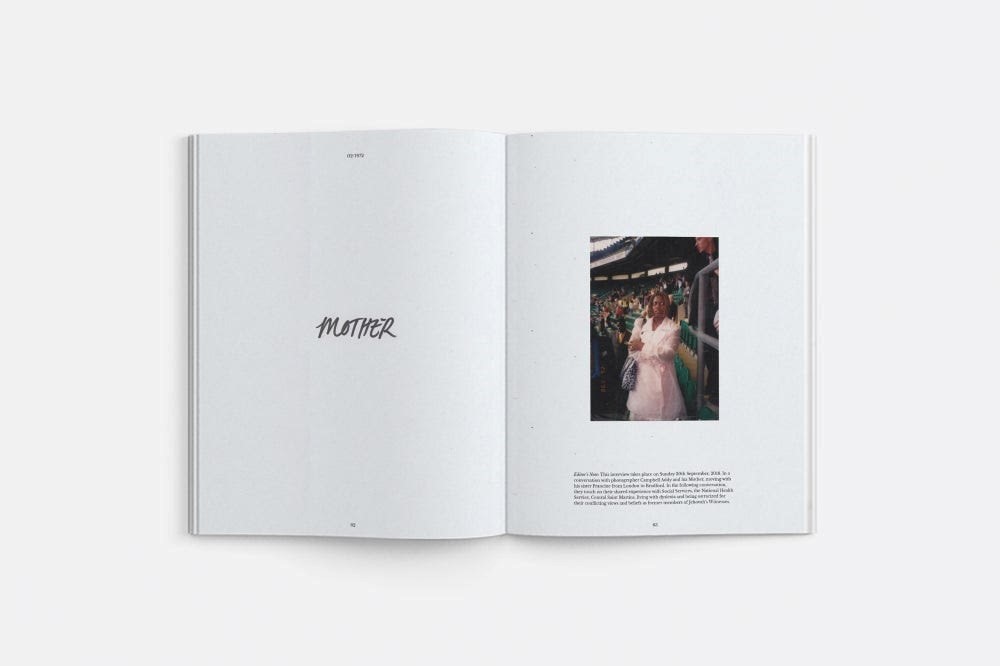This week, 19-year-old Norwegian editor and publisher Elise By Olsen (Recens Paper, Wallet) is the guest editor of AnOthermag.com, presenting a series of articles exploring the current and future state of fashion and art publishing. Alongside conversations with publishers, critics and image-makers, this guest edit offers an intimate insight into her own publications and working practice.
Photographer, filmmaker, publisher and model agent, Campbell Addy is one of the most exciting creative forces to emerge from London in recent years. The mind behind Niijournal and later, Nii Agency, he is now signed to CLM and is widely touted as one of fashion photography’s rising stars.
While his background is in photography, he first got into publishing while creating a photo book for a project during his studies at Central Saint Martins. This ignited a passion: he became fascinated by paper weights and stocks, and began a collection of magazines which now numbers in the thousands. For a final project at Saint Martins he collated a journal of everything everything he’d digested over the course of the last few years – a journal of affairs, so to speak. And that’s how, in 2016, Niijournal came to be – a biannual fashion and culture magazine exploring the issues of empowerment and representation within race. Praised particularly for the way it rethinks black masculinity, the publication serves “to educate, not irritate,” as Addy explains. “If you have racist tendencies, me shouting at you is not going to change those things. I wanted a space and a place to talk about it, not directly but within it, and subtly but surely show what’s going on now, or then,” he says.
2016 proved to be a particularly fertile climate for independent publishing, with a number of new publications breaking through – including Terra Firma, 3 Dot Zine, gal-dem, as well as my own, Recens Paper, and within youth communities it seemed we were all leaning towards print. “All these people were showing me that if you make it worthwhile, print will never die,” says Addy. “We just have to change its purpose. Weekly [publishing] isn’t viable. If you’re part of the print scene, you would know all of these things were going on at the same time. Trying to convince other people is the issue.” Despite the high quality of the magazine, Niijournal is ad-free, sustained originally through Campbell’s own student loan and a Kickstarter campaign. This is just one of the ways Addy refuses to conform to a traditional way of working. “I don’t want to give in to the industry’s model for what a print publication should do. When I travel I bring Niijournal with me and I show people. I don't want it to be stocked in a store just because they have big titles. I want it to be more tailored.”
As a young editor myself, Addy’s approach strongly resonates with me, so I sat down with him for a discussion about independent publishing.

Elise By Olsen: You’ve done three issues of Niijournal. Can you briefly walk us through the different themes you have explored in each issue?
Campbell Addy: Issue one was a literal mirror reflection of my world at that time. I’d met a lot of people in New York, LA, Ghana and online. It was the time of the Black Lives Matter movement, I was in New York when Sandra Bland died and all of these things were happening around me. For me, the first issue was a reflection of the change I wanted to see. I said to artists, ‘give me a representation of you’, of religion, gender, sex, everything. It was hard to commission photographers back then because not many people knew who I was or what Niijournal was. Issue two was more of a celebration of women in music: I had Kelela and Kelsey Lu on the cover. And issue three was about family ties, because I felt like all the connections I had made had turned into my chosen family in the industry. I wanted to pay homage to a lot of people, because without them, publications like Niijournal and photographers like me wouldn’t be able to have such free reign in the industry so early on in our career. I also wanted to highlight some lesser-known artists. This time I got an editor and an editorial designer so I could really step back and just feel. That allowed me to think about the issue as a narrative of a whole, from cover to cover, as opposed to section to section. I basically went back to basics with a more level head to complete the third one.
EBO: Nii is not just a print magazine, it’s also a modelling platform, Nii Agency. What is the relation between the journal and the agency?
CA: I see it as two of my children. Niijournal started first. When I started to seek representation out in a traditional way, going to modelling agencies, it was very hard to find people I wanted. Maybe I was naive, but I was like, ‘why aren’t there people that look different and not so model-esque always?’ The term ‘model’ isn’t just a pretty face. So I started casting for brands, other people and my own shoots, but then I got really tired of casting and casting, and I wanted to keep them all in one place. I would shoot them and get my friends to shoot them. That’s how Nii Agency began. I didn’t have a clue, I had never shot with traditional modelling agencies before, I just said ‘let’s just do it, but do it with a good heart’. As it went on it grew its own branch and stayed in its own lane. The journal and the agency are separate, but they both influence each other.

EBO: In talking about contemporary publishing, it is inevitable that we mention the predicted death of print. What are your thoughts on this?
CA: It’s the same with how I view film photography – most of my first relationships with anything came via the computer or the telephone, but I shoot 90 per cent on film. When I shoot with an older generation of image-makers, from models to clients, they all say ‘oh you shoot on film, wow that’s so cool’. In my mind I’m like, ‘you were the generation that worked solely with film, why are you so shocked?’ Then it dawned on me, they were like ‘boom, technology!’ Technology made it cheaper and quicker, hence why we’re now in this state of fast fashion. But things come in cycles. I think print is a luxury now – not in the price market, but in the sense that if you buy it, it’s really because you want it – and editors and publishers are going to have to design things that we really want. In all honesty, when I pick up a magazine and I read it, I can’t get distracted by a notification on my phone. More than just my visual senses are piqued – from smell to touch, everything. I don’t think print is going to go away, publishers just have to be smarter. Visionaire is a great example; it’s expensive but it’s that ethos we need to learn from. Modern Matter is great; I’m excited to see every issue because it’s different than the previous one. I know they care about print, whereas with other print magazines that have been around for longer it’s subsidiary, it’s their reputation. This needs to change because it’s a shame when you create work and you see it in print and you wish the person cared about the work as much as they did creating the work.
EBO: Are you experiencing a growing demand for print? And do you read a lot of magazines yourself – which ones?
CA: Yeah, I own over 2,000 magazines. If I go past a bookshop in any foreign country I’ll go in. I’m dyslexic so reading is hard and I really have to sit down and focus, so a lot of the books I have are for design. As a photographer I don’t shoot things for digital platform unless it’s a commercial thing – 99 per cent of my images need to be ready for print. That’s why I think print will never die, because we still need it.

EBO: With my now discontinued youth culture magazine Recens Paper, I wanted to bring young people into the global cultural conversation and with Niijournal, you wanted to explore issues of empowerment and representation in regards to race. I think smaller magazines like ours, which publish less frequently, are generally still going strong. Why do you think that is?
CA: We’re going strong purely because of time – we have the time to sit there and curate. That’s what we’re doing; curating a world for people to look at. I know how fast-paced the industry wants us to be, but we choose when our publications come out and they come out for a reason. Again, it’s a shame when people produce magazines when there’s nothing they want to talk about. Independence links back to this concept of time. If you don’t have to abide by the seasonal rules in fashion, then you’re independent.
EBO: I often feel that with smaller magazines it can easily become a one man show. Do you have a team behind you?
CA: Every issue, I have a guest team, which I’m the head of. The way I get to my end goal is so unorthodox that if I had a permanent team it would be too haphazard. There will be teams moving forward for whatever I do now. Two hands are always better than one. Especially being dyslexic, proofreading is harder [for me]. If I wanted to be taken seriously in certain realms of publishing, things like that have to be accounted for.

EBO: How do you choose your contributors?
CA: I choose people who move me. I’m an emotional being. I love people that first and foremost really take care of and have pride in what they do. A contributor might have this amazing photo story that they could give to anyone, but they give it to me and that moves me. I’m very open. It is all about ties and connections.
EBO: Lastly, what changes would you like to see in fashion publishing or publishing in general?
CA: I’d like to see younger people at youth culture magazines. And I’d love to see real old-school journalism come back, as well as a more diverse range of people: more women, more black people. I’d love to see more guest-editing – it’s not easy, but the magazines would have more authentic work out there. I don’t want clout-chasing, click-bait stuff. I’m always blessed when someone asks me to do a job because they think I’m genuinely good for it. Give print more time! We’re the consumers. Everyone I know wants to slow down and a lot of my friends are leaving Instagram. Can you imagine if Vogue came out three times a year? It would become gold. So [I’d like to see] a slower pace, better journalism and actual diversity. I’d love to see a young person guest edit a print issue of Dazed. Elle used to have issues guest-edited by their interns and I’d love to see that ethos shared at other publications.
